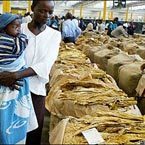
AT least 168 million kg of tobacco worth US$688 million had been exported across the globe by November 20, Tobacco Industry Marketing Board (Timb) data showed last week.
BY FIDELITY MHLANGA
The Timb said shipments for the period were seven million kg above last year’s figure of 161 million kg.
Most of the country’s tobacco crop is shipped to the Far East, the European Union, some African destinations, the Middle East and the American markets.
The crop earned Zimbabwe US$733 million during the same period last year.
According to the Timb, merchants kicked off tobacco shipments to China a fortnight ago, with prices increasing to US$4,10 per kg during the first week of November, from US$3,83 per kg during the week under review.
However, the price remained below what farmers were earning during the same period last year.
This year, local tobacco buyers purchased the crop at an average price of US$2,50 per kg, which was 25% higher than last year’s price of US$2 per kg.
- Chamisa under fire over US$120K donation
- Mavhunga puts DeMbare into Chibuku quarterfinals
- Pension funds bet on Cabora Bassa oilfields
- Councils defy govt fire tender directive
Keep Reading
In 2018, the average tobacco price was US$2,92 per kg, while in 2017 it was US$2,96 per kg.
The drop in export earnings came as the appetite for returning to tobacco farms appeared to be fizzling out during the period, with 127 231 growers signing up for the 2020/2021 season, compared to 138 606 during the same period last year.
With 1 703 new farmers signing up, contract growers constituted 96% of those who had indicated that they would be planting tobacco this year, according to the Timb data.
However, the area under tobacco increased to 28 292 hectares, from 27 181 hectares last year, according to the Timb, which has already rolled out its inputs credit scheme that helps farmers plant the crop.
Most of the tobacco has been planted in Zimbabwe’s traditional golden leaf belts, with Mashonaland West province leading in area planted at 49%, followed by Mashonaland East at 28%, Mashonaland Central with 12,6% and Manicaland province, where 10% of the crop is being grown.
Last week’s statistics mean that farmers are putting larger areas of farmland under tobacco this year, compared to the previous season.
The tobacco industry regulator noted: “10 580 tobacco growers have benefited from the 4 232 tonnes of Compound C fertiliser and 528 tonnes of ammonium nitrate fertiliser distributed by the Timb tobacco inputs credit scheme programme to date.
“The total distributed inputs cover an equivalent of approximately 10 580 hectares.”
During the 2020 season, farmers reeled from an official fixed exchange rate of US$1:$25, which eroded their earnings for the better part of the marketing season before authorities moved to shift the monetary policy in June.
Farmers were getting 50% of their earnings at the US$1:$25 interbank rate fixed by the central bank at the time, but would go on to purchase foreign currency on the parallel market where rates were as high as US$1:$125.
The other 50% was paid out in foreign currency.
Experts said the losses that farmers suffered at the beginning of the marketing season could explain why fewer of them had signed this year.
The Reserve Bank of Zimbabwe has replaced the interbank market with a weekly foreign exchange auction system, which started in June.
But this was after 60% of the crop had been shipped to the market.
As such, tobacco grower associations have been pushing authorities to consider some form of compensation for the losses.
Tobacco exports play a key role in providing critical forex liquidity into the economy.
This year’s golden leaf total output tumbled to 184 million kg compared to 258 million kg the previous season.











